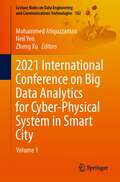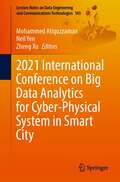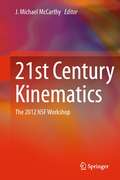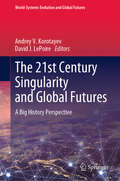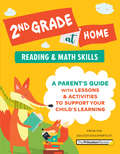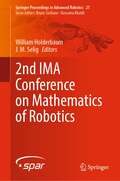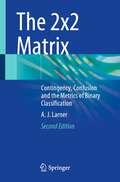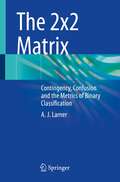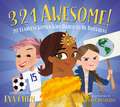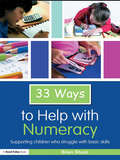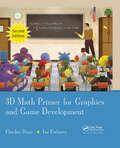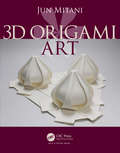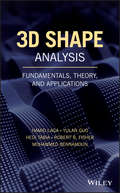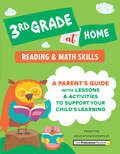- Table View
- List View
2014 Ready Common Core, Mathematics Instruction [Grade] 5
by Curriculum AssociatesNIMAC-sourced textbook
2014 Ready Common Core, Mathematics Instruction [Grade] 6
by Curriculum Associates Llc.NIMAC-sourced textbook
2014 Ready Common Core, Mathematics Instruction [Grade] 8
by Curriculum AssociatesNIMAC-sourced textbook
2014 Ready Common Core, Mathematics Practice [Grade] 7
by Curriculum Associates Llc.NIMAC-sourced textbook
2014 Ready New York CCLS Common Core: Mathematics Practice (Grade #4)
by Curriculum AssociatesThis 2014 Edition contains 2 full-length practice tests, resembling the same question format and difficulty level as in the actual NYS Math Exam.
2014 Ready New York CCLS Common Core Math Instruction Grade 8 (Ready)
by Curriculum AssociatesReady New York CCLS Common Core will ensure that every classroom is current, focused, and on track with the CCSS initiative! Lessons introduce key skills and use examples to walk students through the math concepts, step by step. You'll get both targeted review and extensive practice on open-ended questions.
2014 Ready TNCore, Mathematics Instruction [Grade] 5
by Curriculum Associates LlcNIMAC-sourced textbook
2014 Ready TNCore, Mathematics Instruction [Grade] 7
by Curriculum AssociatesNIMAC-sourced textbook
2014 Ready TNCore, Mathematics Instruction [Grade] 8
by Curriculum Associates Llc.NIMAC-sourced textbook
2021 International Conference on Big Data Analytics for Cyber-Physical System in Smart City: Volume 1 (Lecture Notes on Data Engineering and Communications Technologies #102)
by Mohammed Atiquzzaman Neil Yen Zheng XuThis book gathers a selection of peer-reviewed papers presented at the third Big Data Analytics for Cyber-Physical System in Smart City (BDCPS 2021) conference, held in Shanghai, China, on Nov. 27, 2021. The contributions, prepared by an international team of scientists and engineers, cover the latest advances made in the field of machine learning, and big data analytics methods and approaches for the data-driven co-design of communication, computing, and control for smart cities. Given its scope, it offers a valuable resource for all researchers and professionals interested in big data, smart cities, and cyber-physical systems.
2021 International Conference on Big Data Analytics for Cyber-Physical System in Smart City: Volume 2 (Lecture Notes on Data Engineering and Communications Technologies #103)
by Mohammed Atiquzzaman Neil Yen Zheng XuThis book gathers a selection of peer-reviewed papers presented at the third Big Data Analytics for Cyber-Physical System in Smart City (BDCPS 2021) conference, held in Shanghai, China, on Nov. 27, 2021. The contributions, prepared by an international team of scientists and engineers, cover the latest advances made in the field of machine learning, and big data analytics methods and approaches for the data-driven co-design of communication, computing, and control for smart cities. Given its scope, it offers a valuable resource for all researchers and professionals interested in big data, smart cities, and cyber-physical systems.
21st Century Kinematics: The 2012 NSF Workshop
by J. Michael Mccarthy21st Century Kinematics focuses on algebraic problems in the analysis and synthesis of mechanisms and robots, compliant mechanisms, cable-driven systems and protein kinematics. The specialist contributors provide the background for a series of presentations at the 2012 NSF Workshop. The text shows how the analysis and design of innovative mechanical systems yield increasingly complex systems of polynomials, characteristic of those systems. In doing so, it takes advantage of increasingly sophisticated computational tools developed for numerical algebraic geometry and demonstrates the now routine derivation of polynomial systems dwarfing the landmark problems of even the recent past. The 21st Century Kinematics workshop echoes the NSF-supported 1963 Yale Mechanisms Teachers Conference that taught a generation of university educators the fundamental principles of kinematic theory. As such these proceedings will provide admirable supporting theory for a graduate course in modern kinematics and should be of considerable interest to researchers in mechanical design, robotics or protein kinematics or who have a broader interest in algebraic geometry and its applications.
The 21st Century Singularity and Global Futures: A Big History Perspective (World-Systems Evolution and Global Futures)
by Andrey V. Korotayev David J. LePoireThis book introduces a 'Big History' perspective to understand the acceleration of social, technological and economic trends towards a near-term singularity, marking a radical turning point in the evolution of our planet. It traces the emergence of accelerating innovation rates through global history and highlights major historical transformations throughout the evolution of life, humans, and civilization. The authors pursue an interdisciplinary approach, also drawing on concepts from physics and evolutionary biology, to offer potential models of the underlying mechanisms driving this acceleration, along with potential clues on how it might progress. The contributions gathered here are divided into five parts, the first of which studies historical mega-trends in relation to a variety of aspects including technology, population, energy, and information. The second part is dedicated to a variety of models that can help understand the potential mechanisms, and support extrapolation. In turn, the third part explores various potential future scenarios, along with the paths and decisions that are required. The fourth part presents philosophical perspectives on the potential deeper meaning and implications of the trend towards singularity, while the fifth and last part discusses the implications of the Search for Extraterrestrial Intelligence (SETI). Given its scope, the book will appeal to scholars from various disciplines interested in historical trends, technological change and evolutionary processes.
2nd Grade at Home: A Parent's Guide with Lessons & Activities to Support Your Child's Learning (Math & Reading Skills) (Learn at Home)
by The Princeton ReviewLearn at home with help from the education experts at The Princeton Review! 2ND GRADE AT HOME provides simple, guided lessons and activities that parents can use to help keep 2nd graders on track this year.Anxious about remote learning and hybrid schooling? Worried that the unique circumstances around coronavirus and education might keep your child from getting the help they need in class this year? Want to help support your child's schooling, but not sure where to start?You're not alone! 2ND GRADE AT HOME is a parent guide to supporting your child's learning, with help you can undertake from home. It provides: · Guided help for key 2nd grade reading and math topics· Skills broken into short, easy-to-accomplish lessons· Explanations for parents, plus independent question sets for kids· Fun at-home learning activities for each skill that use common household items· Parent tips, review sections, and challenge activities seeded throughout the bookThe perfect mix of parent guidance, practical lessons, and hands-on activities to keep kids engaged and up-to-date, 2ND GRADE AT HOME covers key grade-appropriate topics including:· early reading comprehension · context & understanding· event order· fiction & nonfiction· place value· addition and subtraction· multiplication· patterns and shapes· charts & graphs· likelihoood ... and more!
2nd IMA Conference on Mathematics of Robotics (Springer Proceedings in Advanced Robotics #21)
by William Holderbaum J. M. SeligThis book highlights the mathematical depth and sophistication of techniques used in different areas of robotics. Each chapter is a peer-reviewed version of a paper presented during the 2021 IMA Conference on the Mathematics of Robotics, held online September 8–10, 2021. The conference gave a platform to researchers with fundamental contributions and for academic and to share new ideas. The book illustrates some of the current interest in advanced mathematics and robotics such as algebraic geometry, tropical geometry, monodromy and homotopy continuation methods applied to areas such as kinematics, path planning, swam robotics, dynamics and control. It is hoped that the conference and this publications will stimulate further related mathematical research in robotics.
The 2x2 Matrix: Contingency, Confusion and the Metrics of Binary Classification
by A. J. LarnerThis book describes, extends, and illustrates the metrics of binary classification through worked examples.Worked examples based on pragmatic test accuracy study data are used in chapters to illustrate relevance to day-to-day clinical practice. Readers will gain an understanding of sensitivity and specificity and predictive values along with many other parameters.The contents are highly structured, and the use of worked examples facilitates understanding and interpretation.This book is a resource for clinicians in any discipline who are involved in the performance or assessment of test accuracy studies and professionals in the disciplines of machine learning or informatics wishing to gain insight into clinical applications of 2x2 tables.
The 2x2 Matrix: Contingency, Confusion and the Metrics of Binary Classification
by A.J. LarnerThis book presents and discusses the numerous measures of test performance that can be derived from 2x2 tables. Worked examples based on pragmatic test accuracy study data are used in chapters to illustrate relevance to day-to-day clinical practice. Readers will gain a good understanding of sensitivity and specificity and predictive values along with many other parameters.The contents are highly structured and the use of worked examples facilitates understanding and interpretation. This book is a resource for clinicians in any discipline who are involved in the performance or assessment of test accuracy studies, and professionals in the disciplines of machine learning or informatics wishing to gain insight into clinical applications of 2x2 tables.
3 2 1 Awesome!: 20 Fearless Women Who Dared to Be Different
by Eva ChenInstagram superstar and New York Times bestselling author of Juno Valentine and the Magical Shoes Eva Chen shines a spotlight on 20 amazing women—including Megan Rapinoe, Sonia Sotomayor, Shirley Chisholm, Greta Thunberg and more!—in 3 2 1 Awesome! a sassy and fun counting board book, perfect for the youngest of budding feminists.Why stick to counting on fingers and toes when you can count:3 straight sets for Billie Jean King's historic win...2 groundbreaking suffragettes named Susan B. Anthony and Elizabeth Cady Stanton...1 singular, sensational YOU!With Derek Desierto's bold and vibrant art, Eva fans and readers of all ages will be transported through "herstory."
3264 AND ALL THAT: A Second Course in Algebraic Geometry
by David Eisenbud Joe HarrisThis book can form the basis of a second course in algebraic geometry. As motivation, it takes concrete questions from enumerative geometry and intersection theory, and provides intuition and technique, so that the student develops the ability to solve geometric problems. The authors explain key ideas, including rational equivalence, Chow rings, Schubert calculus and Chern classes, and readers will appreciate the abundant examples, many provided as exercises with solutions available online. Intersection is concerned with the enumeration of solutions of systems of polynomial equations in several variables. It has been an active area of mathematics since the work of Leibniz. Chasles' nineteenth-century calculation that there are 3264 smooth conic plane curves tangent to five given general conics was an important landmark, and was the inspiration behind the title of this book. Such computations were motivation for Poincaré's development of topology, and for many subsequent theories, so that intersection theory is now a central topic of modern mathematics.
33 Ways to Help with Numeracy: Supporting Children who Struggle with Basic Skills (Thirty Three Ways to Help with....)
by Brian SharpThirty Three Ways to Help with Numeracy equips teachers and teaching assistants with a wide range of practical resources to help children who are having difficulties learning the basic skills of numeracy. By providing a range of activities and games which engage children and encourage motivation in the classroom, the book provides ready-to-use exercises that don’t need lengthy forward preparation. Any materials needed are readily available in the classroom or are provided here to photocopy. The activities are designed using a range of different learning styles to: build learners’ confidence and self esteem develop reasoning and thinking about physical number situations encourage discussions explore numbers by doing The activities can be used with individual children, groups or the whole class. The introduction at the head of each activity describes precisely what it aims to teach the child, followed by clear, concise instructions on how to play each game. Teachers, SENCos and Teaching Assistants will welcome this helpful resource, which complements Thirty Three Ways to Help with Reading also available from Routledge.
3D Math Primer for Graphics and Game Development (Wordware Game Math Library)
by Fletcher Dunn Ian ParberryThis engaging book presents the essential mathematics needed to describe, simulate, and render a 3D world. Reflecting both academic and in-the-trenches practical experience, the authors teach you how to describe objects and their positions, orientations, and trajectories in 3D using mathematics. The text provides an introduction to mathematics for
3D Origami Art
by Jun MitaniEasily Create Origami with Curved Folds and Surfaces Origami—making shapes only through folding—reveals a fascinating area of geometry woven with a variety of representations. The world of origami has progressed dramatically since the advent of computer programs to perform the necessary computations for origami design. 3D Origami Art presents the design methods underlying 3D creations derived from computation. It includes numerous photos and design drawings called crease patterns, which are available for download on the author’s website. Through the book’s clear figures and descriptions, readers can easily create geometric 3D structures out of a set of lines and curves drawn on a 2D plane. The author uses various shapes of sheets such as rectangles and regular polygons, instead of square paper, to create the origami. Many of the origami creations have a 3D structure composed of curved surfaces, and some of them have complicated forms. However, the background theory underlying all the creations is very simple. The author shows how different origami forms are designed from a common theory.
3D Shape Analysis: Fundamentals, Theory, and Applications
by Mohammed Bennamoun Robert B. Fisher Hedi Tabia Yulan Guo Hamid LagaAn in-depth description of the state-of-the-art of 3D shape analysis techniques and their applications This book discusses the different topics that come under the title of "3D shape analysis". It covers the theoretical foundations and the major solutions that have been presented in the literature. It also establishes links between solutions proposed by different communities that studied 3D shape, such as mathematics and statistics, medical imaging, computer vision, and computer graphics. The first part of 3D Shape Analysis: Fundamentals, Theory, and Applications provides a review of the background concepts such as methods for the acquisition and representation of 3D geometries, and the fundamentals of geometry and topology. It specifically covers stereo matching, structured light, and intrinsic vs. extrinsic properties of shape. Parts 2 and 3 present a range of mathematical and algorithmic tools (which are used for e.g., global descriptors, keypoint detectors, local feature descriptors, and algorithms) that are commonly used for the detection, registration, recognition, classification, and retrieval of 3D objects. Both also place strong emphasis on recent techniques motivated by the spread of commodity devices for 3D acquisition. Part 4 demonstrates the use of these techniques in a selection of 3D shape analysis applications. It covers 3D face recognition, object recognition in 3D scenes, and 3D shape retrieval. It also discusses examples of semantic applications and cross domain 3D retrieval, i.e. how to retrieve 3D models using various types of modalities, e.g. sketches and/or images. The book concludes with a summary of the main ideas and discussions of the future trends. 3D Shape Analysis: Fundamentals, Theory, and Applications is an excellent reference for graduate students, researchers, and professionals in different fields of mathematics, computer science, and engineering. It is also ideal for courses in computer vision and computer graphics, as well as for those seeking 3D industrial/commercial solutions.
3rd Grade at Home: A Parent's Guide with Lessons & Activities to Support Your Child's Learning (Math & Reading Skills) (Learn at Home)
by The Princeton ReviewLearn at home with help from the education experts at The Princeton Review! 3RD GRADE AT HOME provides simple, guided lessons and activities that parents can use to help keep 3rd graders on track this year.Anxious about remote learning and hybrid schooling? Worried that the unique circumstances around coronavirus and education might keep your child from getting the help they need in class this year? Want to help support your child's schooling, but not sure where to start?You're not alone! 3RD GRADE AT HOME is a parent guide to supporting your child's learning, with help you can undertake from home. It provides: · Guided help for key 3rd grade reading and math topics· Skills broken into short, easy-to-accomplish lessons· Explanations for parents, plus independent question sets for kids· Fun at-home learning activities for each skill that use common household items· Parent tips, review sections, and challenge activities seeded throughout the bookThe perfect mix of parent guidance, practical lessons, and hands-on activities to keep kids engaged and up-to-date, 3RD GRADE AT HOME covers key grade-appropriate topics including:· early reading comprehension · context and understanding· fiction and nonfiction· event order· problem and solution· addition and subtraction· multiplication and division· fractions and decimals· shapes, symmetry, and patterns· probability... and more!

